► CAR races in Mini JCW Challenge
► Grid of 30+ identical 265bhp racers
► Rabid, rapid miniature touring cars
When this magazine began life as Small Car & Mini Owner in 1962, could anyone have imagined a Mini quite as purposeful, as steroidal, as downright malevolent-looking as the F56 JCW Challenge race car?
More than 30 of these wide-arched, slick-shod machines do battle in the top JCW class of the one-make Mini Challenge championship, and for the opening round of the 2017 season at Oulton Park, CAR’s James Taylor was driving the series’ guest car.
Join him as he parachutes into one of the most competitive championships in the UK…
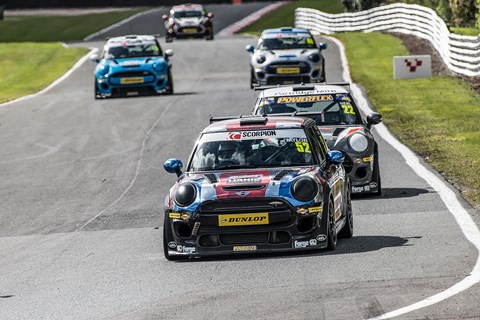
The team
The guest car is run by the Mini UK VIP team, a four-car splinter cell of ExcelR8 Motorsport, the outfit which runs more than 14 cars in total in the Challenge.
Alongside the chrome Union Flag-wrapped car I’m driving, the team is running 2015 Mini Challenge champion Charlie Butler-Henderson, multiple race-winner Rob Smith and James Turkington, brother of double British Touring Car champ Colin.
Elsewhere on the grid, there’s current BTCC driver Jeff Smith (who’s racing in both championships on the same weekend, using a helicopter to get him from BTCC qualifying at Donington Park in time to do the same in the Mini), the Honda factory-backed BTCC outfit Team Dynamics runs two cars for Will and Henry Neal, sons of triple touring car champion Matt, and up and down the field there’s a host of champions and winners from other series in the UK and beyond.
This isn’t going to be easy, then…
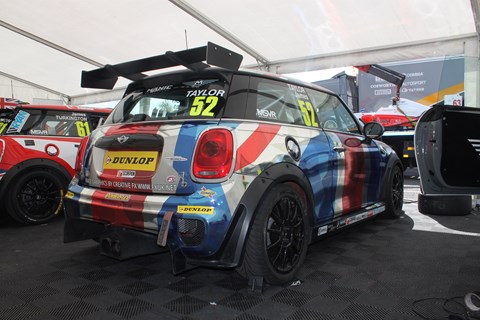
The Mini Challenge race car
Although each Mini Challenge car begins life on the production line at Cowley, it’s whisked away to a very different upbringing. Other than the bodyshell and the rear brakes, the race car shares very little with the JCW road car I drove to the circuit.
Suspension is taken care of by three-way adjustable Nitron dampers, with adjustable camber front and rear, and giant racing brakes at the front. Even the power steering is race-specific, with a different motor mounted on the steering column.
An ECU upgrade bumps the 2.0-litre turbocharged engine’s power output up to around 255bhp, and it’s hooked up to a race-spec limited-slip differential and six-speed sequential Quaife gearbox – more on which in a bit. A Boeing-spec wing sprouts from the tailgate (although it doesn’t create much in the way of meaningful downforce), and certain body panels are changed to fibreglass – including the vent-slashed bonnet and ground-hugging front bumper.
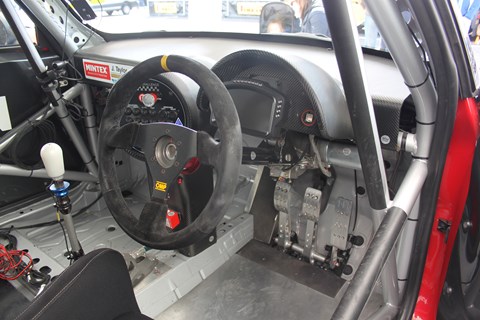
The doors are still steel, but have their inners replaced by carbonfibre panels. Despite all this stripped-out weight-saving, a reassuringly chunky rollcage puts the grammes back on, to a kerbweight of around 1160kg including the driver.
Inside, there’s one seat, a set of beautifully machined racing pedals and a carbonfibre dashboard with a Cosworth digital instrument panel and data logging system. Mini’s trademark gigantic dial still remains in the centre of the dash, but now houses all of the switchgear.
Sounds serious…
Think of the Mini JCW Challenge car as a miniaturised BTCC car; Rob Smith tells me that when he tested with a British Touring Car team last year, other than a bit more power and braking performance, the car felt virtually the same as the Mini, right down to the instrument panel.

How much does a Mini Challenge race car cost?
A brand-new JCW class car costs £41,950 +VAT, or a secondhand one from around £30k. Alternatively, drivers can hire a car from a team rather than own it outright. Budgets for a season’s racing are thought to vary from £20k to £60k.
What’s it like to drive?
In a word, frisky. Mini doesn’t yet make an autonomous car, but the JCW Challenge’s steering certainly seems to have a mind of its own.
Accelerating out of the pits for the first time, the front wheels dart about like a hard-working sniffer dog. Sending more than 255bhp through an aggressive front differential over the cambers of Oulton Park, one of Britain’s most contoured race tracks, gives the steering wheel plenty to think about.
I drive the car for the first time on a Thursday test day before the race weekend, with three sessions to get used to it. I’ve never competed in a front-wheel-drive car before, and the Mini is a very different animal from the Radical SR1 I raced in 2016 and the Ginetta G40 I had a couple of forays in before that, so there’s plenty I need to adapt to.
For example, the fact that although the front slick tyres get warm quite quickly, the rears stay cold, making the first few laps something of an adventure. Happily, when the car does slide there’s plenty of lock to catch it, and the power steering makes life easier.
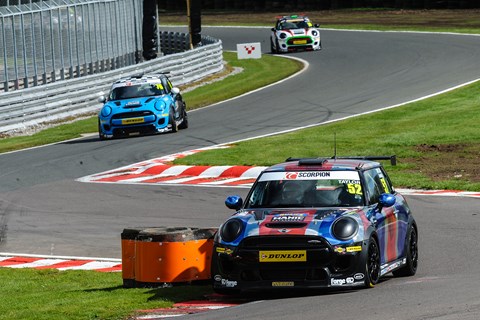
The ABS-free brakes are great, enormously powerful but full of feel, and for a turbo, the engine is really quite flexible and keen to rev. It sounds pretty good, too. As for the sequential gearbox, it’s great fun. Unlike some other racing sequentials, you don’t need to lift your foot from the throttle to shift up a gear – simply leave it pinned, and the ignition automatically cuts as you pull the lever back to select the next ratio.
That means a slightly longer travel on the lever than you might expect, but as long as you’re positive with your actions it’s incredibly effective, switching gears with barely a pause. And popping some pretty impressive flames from the central exhaust, too.
With plenty of suspension travel you can attack Oulton Park’s kerbs harder than in stiffer-sprung racing cars, and many drivers two-wheel their way through the Britten’s chicane. The front-runners have their cars set up on a knife-edge, using oversteer to pivot them into the corners. Mine’s set up with a friendlier, more neutral balance as I learn and build up to race speed, but it’s still very tail-happy. If you thought a road-going JCW was twitchy, you should try one of these…
Between sessions the team’s data engineer Josh Williams goes through the telemetry traces with me. There’s nowhere to hide – every hesitation on the throttle, every early braking point is displayed in black and white (well, full colour) on the graphs. Overlaying my best lap with Rob Smith’s, it’s clear that Rob hits the brakes much harder, and is faster on the downshifts, with a quick one-two punch to the lever compared with my slightly more delayed movements.
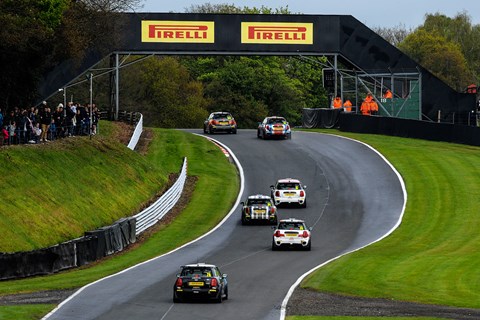
Most of all, I need to lose the fractional ‘limbo time’ between going from full throttle to full brake pressure on the approach to a corner. It’s important to hit the brake as hard as possible initially (‘as if you want to break the pedal’, Williams says), before blending the pressure off gently as you trail-brake into the corner, to keep load on the front tyres.
Plenty to think about before qualifying on Saturday, then…
Qualifying – how does that work?
A 20-minute session, with drivers’ best lap time determining their place on the grid for Race One. The results of that race set the grid for Race Two.
‘Spend the first three laps concentrating on getting heat into the tyres and making sure the rears are warmed up as thoroughly as possible. Then press on,’ race engineer Linton Stutely advises me before we leave the assembly area. New slick tyres need to be warmed up gently or you can tear the surface and create a graining problem that never really goes away. Three laps in, time to crack on – and there’s a red flag to recover a crashed car from the barriers.
We feed back into the pits, and wait for the green light to go again. Now there’ll just be time for a medium-speed lap to warm up the now-cooled tyres before trying for a time. My first ‘proper’ lap is delayed by a spinning car, then I finally get a clear-ish lap on the board, but it’s an average one. The next lap I’m on feels much better, until red flags fly again, this time for a big one. Pick-up racing champion Freddie Lee’s Mini has gone off at the fast Island Bend, with an impact so hard the barrier needs rebuilding. Thankfully he’s okay, but that’s it for the session.

At first I feel despondent – the only decent-ish lap I’ve had chance to get on the board was actually slower than my best on the Thursday practice day and I’ve qualified 14th out of 32 entries.
Charlie Butler-Henderson cheers me up – ‘you didn’t put the car off, and you’re still smiling – why worry?’ And to have qualified more than halfway up a pack of very serious drivers with the knowledge that there’s plenty more time in the car is actually quite a nice feeling.
The rest of the Mini UK team have qualified line astern, with Charlie Butler-Henderson 5th, Rob Smith 6th and James Turkington 7th. They’re in the same boat, with their true pace masked by the interrupted session.
There’s no racing at Oulton Park on an Easter Sunday, so there’s a full day’s gap to reflect before we return on Monday.

Monday – race day
Bank holiday Monday gets off to a soggy start, with the track wet from a morning downpour. For 2017 the Mini Challenge is on the same bill as the British GT championship, and the monster GT cars are on track before us, their giant tyres dispersing the rainwater from Oulton’s curves as they slither and slide around the circuit.
The whole Mini field is starting on wet tyres, but by the time we head out on the formation lap a broad dry line has emerged. The track’s still plenty slippy off-line, though. The one time I’ve raced at Oulton Park previously in the Radical SR1, I got a terrible start when I was wrong-footed by the light sequence. Seems lightning strikes twice; this time the red light sequence is on and off so quickly I’m caught napping, and lose a bunch of places off the line.
Over the opening laps I recover a few positions and wind up behind the young but fast driver George Sutton. Oulton is a quick but narrow circuit, and being a guest driver for the round I don’t want to risk contact, and play it cautiously behind him rather than try a move, eventually losing another place to Ryan Dignan as I tarry behind.
I finish the race P17, with the wet tyres now looking more like slicks, but on the upside my laptimes are well inside the top 10 and I’ve set the fastest first sector of the race. Small victories, eh?
The regular Mini UK team drivers have had a more productive race, with Charlie Butler-Henderson finishing 3rd, Rob Smith 5th and James Turkington 7th.

And Race Two?
By the time Race Two arrives the track is more or less completely dry, and we’re back on slicks.
I get more wheelspin off the line than ideal but I’ve set off at the same time as everyone else, which is an improvement, and arrive at the first corner in the thick of the action. I hook on to the back of a high-speed train of cars and work my way up to 12th, finishing the race with a good dice with Henry Neal, whose skilful defending is too tricky to find a way past.
Up front, there are two Mini UK teammates on the podium as Charlie Butler-Henderson wins the race and Rob Smith takes third, with James Turkington unfortunate to be punted off while battling towards the front.
To finish my first front-wheel-drive race weekend on the fringes of the top 10 with the car still shiny and in the same shape as it started, I’m actually feeling pretty chuffed. In terms of racing experience I’m still raw and green, but the Mini Challenge has smoothed me off and coloured me in a bit, and been a cracking experience from start to finish. The cars are epic fun to drive and the racing is seriously competitive – whoever lifts the Challenge crown this year will have well and truly earned it.
Click here for CAR’s review of the road-going Mini JCW hatch
Pictures by David Young and Jakob Ebrey Photography

Chapter Two: CAR returns to the Mini Challenge
It’s a driver change for our second stint in the Mini Challenge, as Ben Barry takes the wheel.
After James Taylor’s guest drive in the Mini Challenge at Oulton Park earlier this year, the Brands Hatch GP round was my turn behind the wheel.
Quick refresher: the Mini Challenge is an eight-round championship based entirely in the UK that supports the British GT calendar.
The series has been running since 2001, but was taken over five years ago by Justina and Anthony Williams. With backgrounds as a recruitment specialist and financial advisor respectively, both Justina and Anthony have previously raced in the championship. Today, Anthony runs the championship, while Justina manages Excelr8 Motorsport, which looks after 12 of the cars on the grid, including the guest car I’m driving.
The pair bought the series with a 17-car grid, but now the top-tier JCW class has grown to between 26 and 31 cars, with peak, multi-class grids of 65.
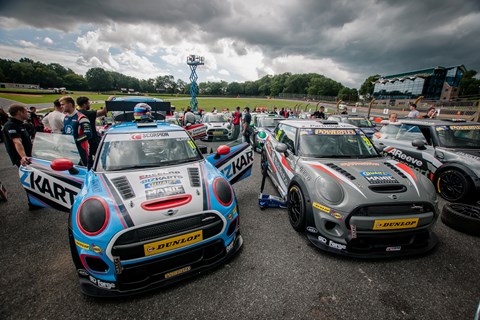
Twenty-six exclusively JCW-spec cars entered the Brands Hatch round. These cars are stripped out and fitted with a rollcage and Corbeau bucket seat, and run 2.0-litre turbocharged engines built by Damico producing 265bhp. The spec also includes a six-speed Quaife sequential gearbox, limited-slip diff, three-way adjustable Nitron dampers, huge Alcon brakes and either a wet or slick Dunlop control tyre.
‘We want it to be the nearest thing to a touring car,’ explains Anthony, ‘and for the drivers to see the Mini Challenge as a stepping stone to the BTCC.’
Cars cost £42k plus VAT, used examples are available for around £30k, and 2017 champion David Grady is said to have spent under £25k on the season, preparing the car with his dad. Arrive-and-drive packages are available for £40-£50k. The Cooper Pro, Cooper Am and Open Class offer considerably reduced costs.
Testing began on the Friday, and I quickly got to know my four-man crew: team manager Oli Shepherd, data engineer Josh Williams, and number one and number two technicians Matt Saunders and Rob Bodsworth. The atmosphere was both reassuringly professional and relaxingly comfortable, and I quickly felt at home. I was sharing a garage with Rob Smith (winner of the previous round on the Brands Indy circuit) and previous champion Charlie Butler-Henderson. Again, both were welcoming, and happy to share tips and data with the newbie.
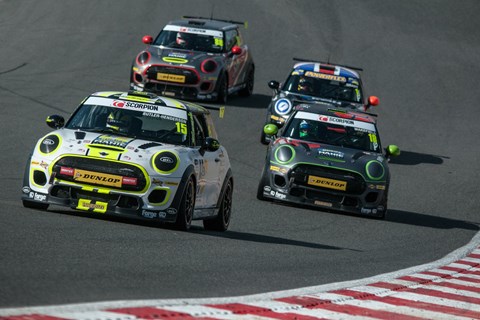
The first test session gave me a feel for the Mini in hot, dry conditions. Despite the intimidation you feel in its stripped, serious-feeling cabin, the Mini is easy to drive, save for being extremely tail-happy on cold tyres. The transformation as the tyres gain heat is remarkable: the ice-like skittishness vanishes, replaced by a rear end that feels very keen to adopt some angle to help you turn in to a corner, but has a confidence-inspiring gumminess too.
When you learn to trust that, everything starts to flow: the turbo engine is mapped to progress to 6550rpm in a linear, naturally aspirated kind of way, the brakes provide huge, easily modulated stopping power (the lack of ABS never feels an issue) and pulling back the long wand of a gear lever to slam home gear changes with your right foot planted is a massively satisfying feeling – though you need the clutch to get back down the ratios, and to get the car off the line.
My only benchmark is the Clio Cup racecar, and I found the Mini’s diff less aggressive – you get relatively modest wheelspin and understeer if you accelerate early in the Mini, which gives you a very clear feeing for the limit – and its rear end seemed more mobile, traits I both preferred. Unfortunately, my car’s power steering was acting up, causing a lumpiness to the assistance.

While techs Matt and Rob got to work diagnosing the problem, I sat down with data engineer Josh and his laptop. He gave me a big boost saying I’d adapted quickly considering my greater familiarity with rear-drive cars on track, and revealed I was about two seconds a lap adrift of pace-setter Rob Smith. My brake pressure was good, but I’d improve if I picked up the throttle sooner.
That power steering issue kept raising its head – we aborted the second session because I just wasn’t strong enough to drive the car and got a couple of scares when it snagged violently on kerbs – and while I managed to build in some of Josh’s data-driven advice, I wasn’t getting any faster. The data also showed up a waviness to the way I was releasing the brake pedal, something I thought might relate to trying to keep some stability as the back end moved about. I needed to stop it, but wasn’t sure if I could because it seems to be fizzing away somewhere deep in my hardwiring. Not to worry, said Josh, your technique is improving, the speed will come from that. ‘Just go out, enjoy it, and bring the car back safe.’
Noise restrictions meant we wouldn’t experience the full GP circuit until qualifying the next day. This was slightly alarming, as I’d never driven it before, though a good few of the regulars were in the same boat. One of which seemed to be required as we took to the circuit the next day.
Despite an otherwise baking hot Saturday, a thunderstorm coincided precisely with our entire session, leaving Matt and Rob to get soaked as they quickly swapped my slicks for wets in the assembly area. With streaming water all over the circuit and limited visibility, it was a pretty intimidating time to be introduced to the faster curves and limited run-off of the GP loop for the first time, but the Mini actually felt extremely planted – the tyres cut through the water, and I suspect that pulling for sixth gear into Pilgrim’s Drop while barely being able to see the pack of cars I was running with will stay with me forever.

It was a pretty messy, short session, one interrupted by multiple offs and flags, and I never felt particularly happy to really push, but on what turned out to be the last lap I gave it a go and ran too deep into the Druids hairpin where several other cars had gone off. The data showed me frantically pumping the pedal to get it back under control, and it was a relief when I did. But that error also blighted what was my best lap before the session ended under yellows, and I ended up 25th of 26, falling from the 19th slot I’d occupied just a lap or so earlier.
Nonetheless, the team stood out in the pitlane, soaked to the bone, to give me a round of applause. That felt pretty good. Later, the data showed my braking spots and pressure were about there with pole-sitter Rob Smith (and the waviness had almost disappeared, something I attributed to different conditions and lower speeds) but my mid-corner speed was too low as I struggled to commit to the throttle and believe the car wouldn’t wash wide onto the grass.
Thankfully it was sunny for race one on Sunday, and as I got ready to line up at the back of the grid, I realised there was less pressure in that I could only move forward and was unlikely to be hit from behind. Multiple BTCC champ Matt Neal is running his sons Will and Henry in the Mini Challenge, and I asked what he’d do in my race shoes. ‘The race will come to you,’ he said. It was the calming bit of advice from a Jedi master that I really needed.
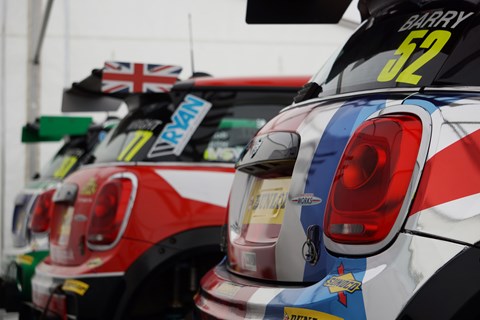
I could barely see the start lights because I was so far back on the curved grid, got a terrible start – too much wheelspin, which made the car baulk at the first to second gear shift, and the diff pulled me hard downhill to the right – and I took it cautiously into Paddock Hill Bend because the tyres’ cold performance still spooked me. But as a pack of cars crashed ahead, I managed to pick a line straight through the middle and keep my speed up.
Steady through Druids, I carried a little more speed into the downhill left at Graham Hill, and felt the rear start to slip. Gah! Thankfully I wound on enough steering, then picked my way through another two or three spinners as we turned left uphill through Surtees, linking on to the GP circuit. The race was coming to me! Sadly, the carnage was such that a re-start was called, and I lined back up on the grid where I’d started. Gutted!
My second start wasn’t much better, and the racing was painfully brief, with just a handful of laps before the yellow flags waved for another shunt until the end of the shortened session. I remember passing one car, but ended the race five places ahead of where I started, in 20th, no doubt more because of the high attrition ahead than any skill behind the wheel. Rob Smith led from lights to (yellow) flag.
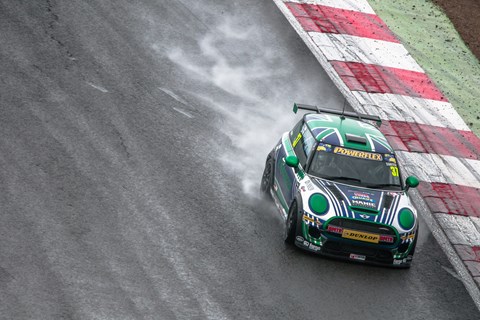
I started the next race further up the grid in 20th, made a marginally better start – I found launching the Mini the most foreign part of driving it – but still lost a couple of places. We all got through Paddock cleanly this time, and it was all pretty busy funnelling into the tight right at Druids.
Under braking I heard a small bang, presumed it was light contact, but when I glanced in my left mirror exiting Druids, I noticed the left window had smashed. As glass fell into the cockpit, I slammed down my visor. Even now, we’re not sure what happened, but gravel flicked up off the circuit is one possibility.
We all got through Hawthorn’s, the very fast right-hander, but as we braked hard for Westfield, I could see cars spinning and my options quickly reducing as I couldn’t actually brake any harder, but somehow I managed to miss the melee.
Soon after, teammate for the weekend Rob Smith made a great move into Clearways, but moved over a little too early and made contact with another car, which fired him into the pitwall and off down the track. The yellow flags were waving as we came through at full speed, Rob stranded and unsighted, but there was no further contact, and from there, things kind of settled into a groove. I lost a few places as faster cars came through, gradually fell away from the pack I was chasing, and kept a reasonable gap to the cars behind, but there wasn’t so much dicing. The power steering issue also quickly returned. Did it slow me down? I’m not sure, but it certainly robbed the car of its fluidity and accessibility.

But it was also an incredible feeling to drive as fast as I could on the criminally under-utilised GP circuit. It’s such a fast, wide, undulating, ballsy place, some corners holding you in with deeply banked cambers, others threatening to pitch you off as they tumble away.
I was always too hesitant through Hawthorn, and never quite nailed Paddock Hill, and lapped at a best of around four seconds off the leaders.
While I’m confident I could have pushed harder and reduced that lap time, I’m not sure I’d have done it without dropping the car at some point – feeling the car move around in fourth at the entry to Clearways and then push out towards the grass on the exit underlined that. Better to maintain a pace I could repeat, keep the car intact and get the reasonable finish I badly wanted.
Not that I didn’t make errors. The most bizarre, I seem to remember, was shifting to sixth from fifth under braking for Westfield, instead of fourth. Somewhere in my head, I reckon, I saw fifth on the dash, and regressed to pull-back-for-fourth road-car logic. That lost me a chunk of time and let the chasing cars edge closer. Funny how simple things can get confused when you’re becoming overloaded.
Thankfully, I kept the others behind and crossed the finish line 17th, 72 seconds behind winner Brett Smith after around 22 minutes! Without the small errors and the power steering, perhaps 16th could have been mine, but I felt pretty chuffed to get over the line after my first time on the GP circuit in the dry, the car still as shiny as it arrived on Friday save for that mystery smashed window.
After a weekend as its guest, I reckon the Mini Challenge could well be the ideal stepping stone to touring cars. The cars are easy for only modestly experienced drivers like me to immediately go relatively fast in, but the intensity of competition is fierce. Make it here and, chances are, you’ll do the business there.